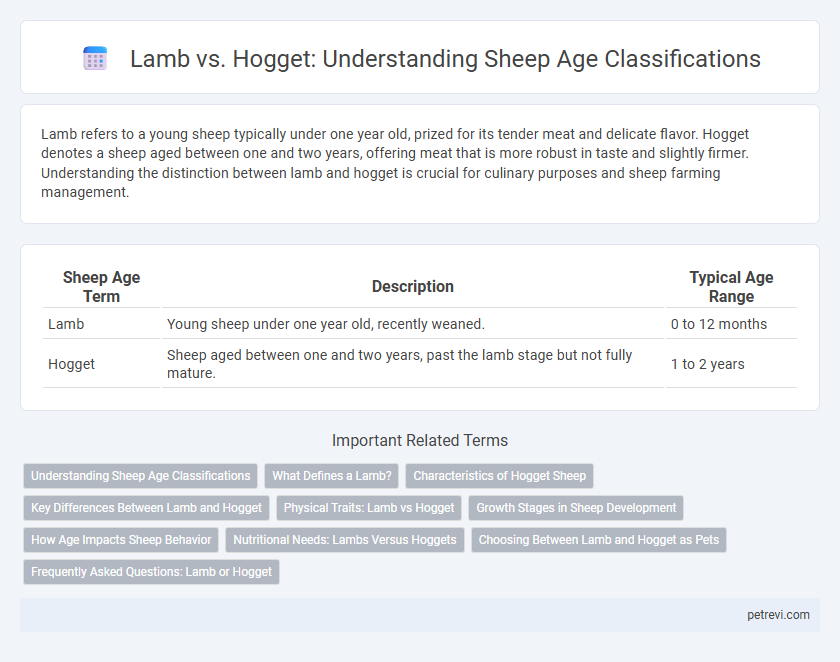Lamb refers to a young sheep typically under one year old, prized for its tender meat and delicate flavor. Hogget denotes a sheep aged between one and two years, offering meat that is more robust in taste and slightly firmer. Understanding the distinction between lamb and hogget is crucial for culinary purposes and sheep farming management.
Table of Comparison
| Sheep Age Term | Description | Typical Age Range |
|---|---|---|
| Lamb | Young sheep under one year old, recently weaned. | 0 to 12 months |
| Hogget | Sheep aged between one and two years, past the lamb stage but not fully mature. | 1 to 2 years |
Understanding Sheep Age Classifications
Lamb refers to sheep under one year old, characterized by tender meat and a mild flavor, while hogget denotes sheep aged between one and two years with more developed muscle and a richer taste profile. Understanding these age classifications is essential for farmers, butchers, and consumers to ensure optimal meat quality and culinary applications. Correctly identifying lamb and hogget stages also aids in managing breeding cycles and market pricing strategies effectively.
What Defines a Lamb?
A lamb is defined as a sheep under one year of age, typically less than twelve months old, known for its tender meat and finer texture. Lambs are identified by the presence of baby teeth, which have not yet been replaced by permanent teeth, distinguishing them from older sheep. The classification is crucial for farmers and consumers seeking quality meat with specific flavor profiles and tenderness.
Characteristics of Hogget Sheep
Hogget sheep, aged between one and two years, display a more developed muscle structure and thicker bone density compared to lambs, enhancing meat quality with a richer flavor and firmer texture. They typically retain finer wool than older sheep, providing versatile use for both meat and wool production. The maturity of hoggets results in distinct carcass traits, including improved fat distribution and stronger connective tissues, which benefit culinary applications.
Key Differences Between Lamb and Hogget
Lamb refers to sheep under one year old, characterized by tender meat and a mild flavor, while hogget represents sheep aged between one and two years, offering firmer texture and richer taste. The key differences include muscle development, fat distribution, and flavor intensity, with hogget having a more pronounced, gamey flavor compared to lamb. Understanding these age-related distinctions is crucial for culinary uses and market classification within the sheep industry.
Physical Traits: Lamb vs Hogget
Lambs typically have softer, finer wool with a smoother coat and smaller, more delicate hooves, indicating their younger age. Hoggets display coarser wool, slightly rougher texture, and more developed hooves along with a fuller body frame, reflecting their transition from lamb to mature sheep. These physical distinctions help farmers accurately determine sheep age and manage flock breeding cycles efficiently.
Growth Stages in Sheep Development
Lamb refers to a sheep up to 12 months old, characterized by rapid growth and tender meat due to its early development stage. Hogget denotes a sheep between 12 to 24 months, marking the transition from juvenile to mature physiology, with firmer meat and more developed muscle structure. Understanding these growth stages is crucial for optimizing sheep breeding, meat quality, and livestock management practices.
How Age Impacts Sheep Behavior
Lambs, typically under one year old, exhibit playful and curious behaviors, reflecting their early developmental stage, while hoggets, between one and two years old, display more cautious and exploratory behaviors as they transition to maturity. Age influences their social interactions, with lambs showing higher dependency on the flock and hoggets beginning to establish dominance hierarchies. Understanding these behavioral shifts aids in effective sheep management and welfare optimization across different age groups.
Nutritional Needs: Lambs Versus Hoggets
Lambs, typically under one year old, have higher protein and energy requirements to support rapid growth and development, necessitating nutrient-dense feeds rich in essential amino acids and vitamins. Hoggets, aged between one and two years, require balanced nutrition to maintain health and prepare for reproductive maturity, with a focus on adequate fiber and mineral intake to support metabolic functions. Understanding these distinct nutritional needs optimizes feeding strategies for improved flock health and productivity.
Choosing Between Lamb and Hogget as Pets
Lambs, typically under one year old, are characterized by their softer wool and gentler temperament, making them more suitable for first-time pet owners seeking manageable care requirements. Hoggets, aged between one and two years, offer a more developed physique and stronger disease resistance but may exhibit more independent behavior, requiring experienced handlers. Understanding the distinctions in growth stages, nutritional needs, and behavioral traits between lambs and hoggets is essential for selecting the right sheep age as a pet.
Frequently Asked Questions: Lamb or Hogget
Lamb refers to a sheep under one year of age, typically less than 12 months old, known for its tender meat and mild flavor, while hogget is a term used mostly in New Zealand and Australia for a sheep between one and two years old, offering a richer taste and firmer texture. The distinction between lamb and hogget is primarily based on the animal's age and development, which affects meat quality and culinary uses. Consumers often ask which is better for cooking, with lamb favored for roasting and grilling due to its tenderness, while hogget is preferred for slow-cooked dishes because of its stronger flavor profile.
Lamb vs Hogget for Sheep Age Infographic

 petrevi.com
petrevi.com